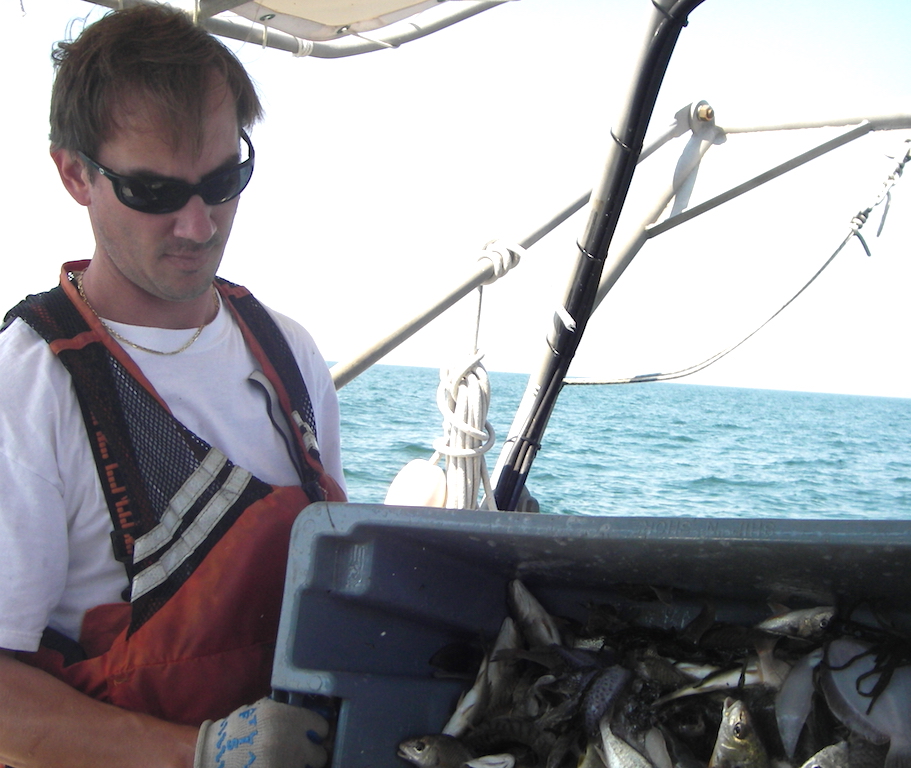
Features
Research
Reproductive fitness affected by hypoxia in Chesapeake study
A study of hypoxia that started in a lab, then moved to the Gulf of Mexico, has now found its way to the cold waters of Northeastern United States in Chesapeake Bay. That is where researchers Troy Tuckey and Mary Fabrizio at the Virginia Institute of Marine Science are looking at how naturally occurring hypoxia in the Chesapeake Bay area is affecting fish resources, namely the Atlantic Croaker (Micropogonias undulates). The laboratory study found that the gonads of fish exposed to low levels of oxygenated water (hypoxia is considered DO ≤ 2 mg/L) were smaller than fish exposed to normoxic (normal oxygen levels) due to endocrine disrupters.
June 28, 2017 By Heather Wiedenhoft
 Researchers at the Virginia Institute of Marine Science are looking at how naturally occurring hypoxia in the Chesapeake Bay area is affecting fish resources and how this is affecting aquaculture
Researchers at the Virginia Institute of Marine Science are looking at how naturally occurring hypoxia in the Chesapeake Bay area is affecting fish resources and how this is affecting aquacultureThe original lab study was done indoors, independent of other natural environmental stressors often found in estuaries such as limited food supply, harmful algal blooms, fluctuating salinity levels, etc., and so was a clear indicator of hypoxia alone being a stress on fish tissues.
Researchers at the Virginia Institute moved the croaker study outdoors and looked at three tributaries that feed Chesapeake Bay. Monthly fish collection and data were gathered before and during hypoxic conditions from May to August 2011. They found that the different tributaries displayed different environmental conditions:
• York River- short tidal cycles result in short term hypoxia
• Rappahannock- summer-duration, long-term hypoxia
• James River- normally oxygenated water
In the Rappahannock, Troy found “…the croakers are essentially squeezed up into the fresh water headwaters of the river to escape from the summer-long oxygen depletion near the Bay. In the York, tidal fluctuations brought on short bursts of hypoxia that would “….shift the benthic community to the more oxygenated surface waters and into the waiting mouths of larger fish…” And in the James the waters displayed normoxic conditions year-round and were used as a control for the study.
Interestingly, they found mild hypoxia actually enhanced ovarian lipid content when it was short term (hours to days) compared to the control, or normoxic fish. This was possibly due to increased feeding on displaced benthic communities, and lead to a positive correlation to reproductive readiness. The findings for severe long-term hypoxia on fish in the Rappahannock River showed, as expected, a decrease in gonadal lipid content and a likely decrease in reproductive fitness and success. This was similar to the results found in lab studies.
Troy points out that the study is …”just one snapshot in time, but that it may help other researchers with stock assessments for fish in the Chesapeake Bay system…” Often these are done as an overview for an area, sometimes without in-depth site specific studies and environmental factors being taken into consideration. He feels that in the past, models could overestimate population growth by not factoring in the effects of hypoxia on fish reproductive success.
Researchers are working hard to address these problems, and Troy and partners are excited by new and emerging technology that will allow biomarkers specific to hypoxia to be identified in fish DNA.
— Heather Wiedenhoft
Heather Wiedenhoft is a Research Scientist at WSU in Vancouver, Washington.
The aquaculture connection
One particular concern relating to hypoxia would be fish grown in aquaculture operations. With the likely increase in eutrophication and hypoxia in both inshore and offshore waters in the future, the mobility-constrained fish in open water pens are at a greater risk to low oxygen conditions. The Philippines, as with many other Asian countries, regularly see massive summer fish kills in natural embayments used for aquaculture. The bays, filled with pens of milkfish, are a source of seasonal hypoxia owing to over-crowded pens minimizing water flow, large algal blooms due to eutrophication, and the resulting depletion of oxygen from decomposing fish and algae. As aquaculture moves offshore and into deeper waters, oxygen will still be a limiting factor in many places around the world that seasonally develop severe bottom water hypoxia.
Print this page





